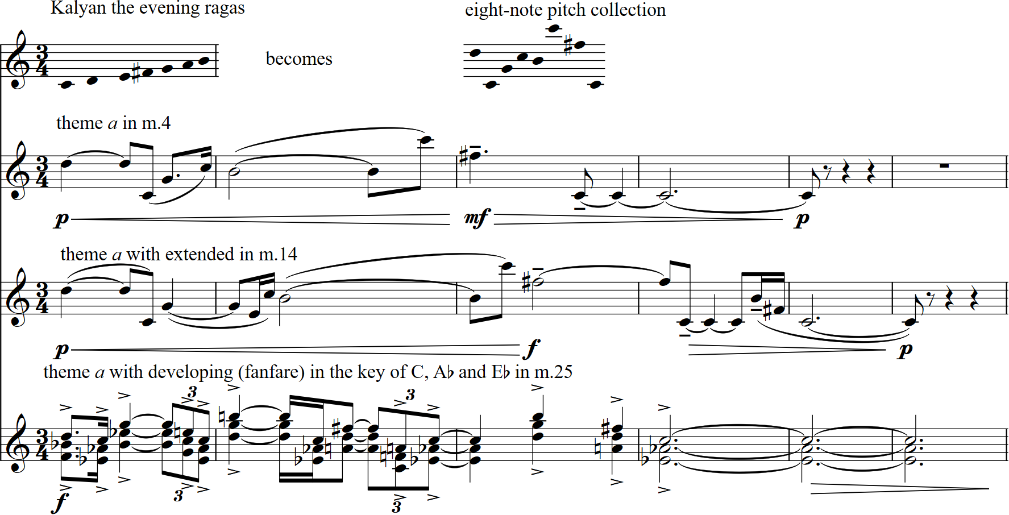Utilizing Indian Ragas in the Symphonic Poem “The Ramayana”
Main Article Content
Abstract
The symphonic poem “The Ramayana” is an original composition for symphony orchestra, inspired by the ancient Ramayana of the Indian poet Valmiki. The work is presented as a symphonic poem in seven movements. My compositional process was an exposition of musical themes based on the Indian Hindustani ragas (traditional melodic frameworks for improvisation) that were created with a combination of the raga notes and the English letters of each movement title. The story was told using ragas (which imply certain moods) along with polyphonics and other Western compositional techniques. This article focuses on the novel compositional techniques behind the work that I, as a composer educated in both philosophy and the musical procedures, used to create the piece.
Article Details
References
Bakshi, H. (2005). 101 raga-s for the 21st century and beyond. Cheshire: Trafford Publishing.
Baraniuk, R. (1999). Indian classical music. Tuning and ragas. https://cnx.org/contents/bDLyHWWs@16/Indian-Classical-Music-Tuning (accessed 1 August 2016).
Bor, J. (1999). The raga guide: A survey of 74 Hindustani ragas. Monmouth, United Kingdom: Zenith Media Limited.
Brockington, J.L. (1970). “Stereotyped expressions in the Ramayana”. Journal of the American Oriental Society, Vol. 90, No. 2, pp. 210-227.
Brown, K.B. (2003). “The That system of seventeenth-century North Indian ragas: A Preliminary report on the Treatises of Kamilkhani”. Asian Music, Vol. 35, No. 1, pp. 1 -13.
Danielou, A. (1949). Northern Indian music: Volume One – theory & technique. London: Christopher Johnson.
Danielou, A. (1949). Northern Indian music: Volume Two – the main ragas. London: Halcyon Press.
Gangoly, O.C. (1935). Ragas & Raginis: Nalanda books on Asian Art. Mr. V.N. Bhatkhande. B.A., LL.B., of Bombay
Grout, D.J. & Palisca, C.V. (1996). A history of Western music. New York: W.W. Norton & Company.
Hopkins, E.W. (1926). “The Original Ramayana”. Journal of the American Oriental Society, Vol. 46, pp. 202-219.
Jairazbhoy, N.A. (2018). The Raga of Northern Indian Music: Their Structure and Evolution. London: Faber and Faber.
Kats, J. (1927). The Ramayana in Indonesia. Bulletin of the School of Studies, University of London. Vol.4, No.3, pp. 579-585.
Kaufmann, W. (1965). Rasa, Raga-Mala and performance time in North Indian Ragas. Ethnomusicology, Vol. 9, No. 3, pp. 272-291.
Kennan, K. & Grantham, D. (2002). The technique of orchestration. New Jersey: Upper Saddle River.
Kosta, S. (2006). Materials and Techniques of Twentieth-Century Music. New Jersey: Pearson Prentice Hall.
Kosta, S., Payne, D., Almen, B. (2013). Tonal harmony with an introduction to
Twentieth-Century Music. New York: McGraw-Hill.
Krishnaswami, S. (1971). “Musical Instrument of India”. Asian Music, Vol. 2, No. 2, pp. 31-42.
Menon, R. (2001). The Ramayana: A modern retelling of the great Indian epic. Lincoln, Nebraska: North Point Press.
Mendl, R.W.S. (1932). “The art of the symphonic poem”. The Musical Quarterly. Vol. 18, No. 3, pp. 443-462.
NOIS. (2019). Carnatic Music Secondary of Level Course Theory Book 1. New Delhi: Govt. of India.
NOIS. (2019). Hindustani Music Secondary of Level Course Theory Book 1. New Delhi: Govt. of India.
Pollock, S. (2016). “Ramayana and political imagination in India”. The Journal of Asian Studies, Vol. 52, No. 2 (May, 1993), pp. 261-297.
Poolthupya, S. (2006). “The Influence of the Ramayana on Thai Culture: Kingship, Literature, Fine Arts and Performing Arts”. Vol. 31, No. 1 (January – March 2006), pp. 269-277.
Ramesh, Y. (2016). “Influence of Ramayana on the Life, Culture and Literature in India and Abroad”. International Journal of Engineering Science and Computing, Vol. 6, No. 8 (August, 2016), pp. 2453-2459.
Randel, D.M. (2003). The Harvard Dictionary of Music. Massachusetts: The Belknap Press of Harvard University Press.
Spencer, P. & Temko, P.M. (1994). A practical approach to the study of form in music. New Jersey: Waveland Press.
Sadhana, (2011). Hindustani classical music. Scale-Raga. 2011. http://raag-hindustani.com/Scales1.html
Stoll, D. (1941), “The Eastern Modal Influence. Music and Letters”, Vol. 22, No. 2, pp. 135-138.
Suphanrojn, P. (2016). The symphonic poem “The Ramayana”.


